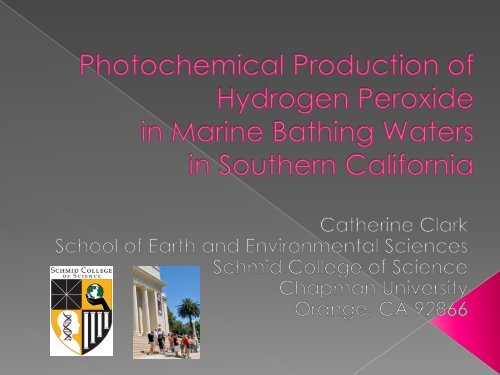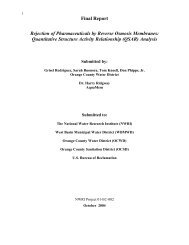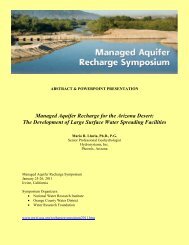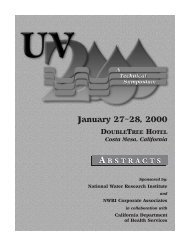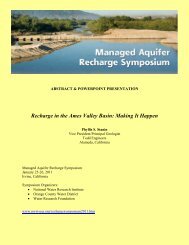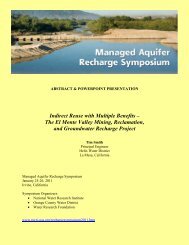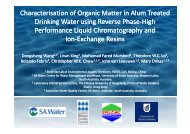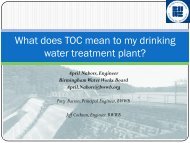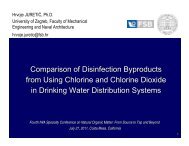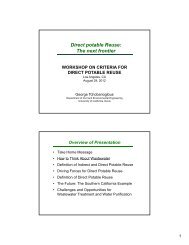Presentation - National Water Research Institute
Presentation - National Water Research Institute
Presentation - National Water Research Institute
Create successful ePaper yourself
Turn your PDF publications into a flip-book with our unique Google optimized e-Paper software.
Why is peroxide important?<br />
Typical levels in seawater<br />
Production mechanism in seawater<br />
Southern California surf-zone waters<br />
› Lab and mesocosm experiments<br />
› Temporal and spatial measurements<br />
› In situ diel studies<br />
Potential additional sources<br />
Conclusions/future work
Hydrogen peroxide (H 2 O 2 ) occurs naturally<br />
in fresh and marine waters<br />
Important intermediate in redox processes<br />
in chemical and biological aquatic systems<br />
Acts as a strong oxidizing agent that reacts<br />
with trace metals and pollutants<br />
Elevated levels of H 2 O 2 have been shown to<br />
cause damage and cell lysis in<br />
microorganisms<br />
Potential impacts on microbial water<br />
quality
Microbial water quality standards for marine<br />
recreational bathing waters.<br />
Public beaches with >50,000 visitors/year mandated<br />
to participate in water quality monitoring programs.<br />
Microbial water quality assessed from concentration<br />
of fecal indicator bacteria (FIB; US EPA).<br />
Beach closures and postings when levels are<br />
exceeded.<br />
Observed diel cycles in surf zone<br />
› lower bacteria levels during the day<br />
Diel cycling attributed to:<br />
› UV radiation-induced mortality<br />
› biological predation<br />
› oxidative stress from natural photochemically-produced<br />
oxidizing agents like H 2 O 2
Field measurements in surface seawater over last two<br />
decades (review Clark et al., 2008).<br />
Prior measurements in mid-ocean and near-shore waters<br />
Concentrations from
Endogenous conc.of 100 nM and 10 000 nM for exogenous<br />
H 2 O 2 increased catalase hydroperoxidase in E.coli<br />
(Gonzalez-Flecha& Demple, 1997).<br />
Cells exposed to sunlight may be sensitized to lower<br />
concentrations.<br />
Some evidence for bacterial mortality from oxidative stress<br />
at lower exogenous conc. of 10 2 nM eg.<br />
› Angel et al. (1999) ~100 nM H 2 O 2 caused oxidative stress to<br />
bacteria in coastal waters as indicated by increasing catalase<br />
enzyme concentration<br />
› Xenopoulos & Bird (1997) spiked lake waters incubated in situ<br />
with 100 nM H 2 O 2 and observed inhibition of bacteria by ~40%<br />
› Kohn & Nelson (2007) concluded that indirect photoinactivation<br />
by photochemically produced reactive oxygen species was<br />
more important than direct damage by UVB light in sunlightmediated<br />
inactivation of MS2 coliphage in waste stabilization<br />
ponds.
What are H 2 O 2 production and<br />
destruction mechanisms and<br />
concentrations in the dynamic surf<br />
zone environment where FIB levels<br />
are monitored and regulated?
Photochemical production from CDOM<br />
considered primary source in natural waters<br />
› higher H 2 O 2 concentrations and production<br />
rates observed in waters with higher levels of<br />
CDOM as measured by absorbance and<br />
fluorescence<br />
Other sources to surface seawater include<br />
› atmospheric input via dry and wet deposition<br />
› biological production by algae<br />
› largely insignificant compared to in situ abiotic<br />
photochemical production<br />
› wet deposition an intermittent significant source<br />
over localized areas during rain events
Net oceanic decomposition rates show<br />
considerable spatial variability; generally<br />
first order with a lifetime
CDOM refers to a spectrum of highly complex<br />
macromolecular colored compounds that include<br />
humic substances.<br />
Most CDOM in coastal waters comes from riverine or<br />
wetland inputs of terrestrially derived materials from<br />
plant degradation<br />
May also be produced from grazing phytoplankton<br />
and viral-induced lysis in the ocean<br />
Example of 3D Excitation Emission<br />
Matrix(3D EEM) fluorescence<br />
for CDOM in surf zone waters
CDOM absorbs sunlight.<br />
Rxn of O 2 with photoexcited CDOM gives superoxide O 2- (1) and its<br />
conjugate acid HO 2 (2) which dismutate to form H 2 O 2 and oxygen (3-5)<br />
(Cabelli, 1997):<br />
CDOM* + O 2 → CDOM + + O 2<br />
-<br />
(1)<br />
O 2- + H 2 O → HO 2 + OH - (2)<br />
HO 2 + HO 2 H 2 O 2 + O 2 k =8.6 x 10 5 M -1 s -1 (3)<br />
2 O 2 O 2<br />
2-<br />
+ O 2 k =
H 2 O 2 levels had never been directly measured in the surf zone<br />
where microbial water quality is monitored.<br />
To assess the importance of H 2 O 2 in monitored marine<br />
recreational waters, we conducted a spatial and temporal study<br />
of surf zone concentrations at popular bathing beaches in<br />
Southern California on short (24 h in situ field studies; 30 to 60 min<br />
intervals) and long (weekly/monthly/annual) time scales.<br />
Focused much of this study on Huntington State Beach as part of<br />
a larger multi-investigator study aimed at elucidating sources<br />
and cycling of surf-zone FIB (Boehm et al., 2002; Grant et al.,<br />
2005).<br />
Discuss trends observed between H 2 O 2 levels and tide, time of<br />
day and season.<br />
Compare concentrations, production and loss rates obtained in<br />
the surf zone to previous near and off-shore seawater studies.
Enzyme-mediated fluorescence peroxidase technique by<br />
Zika and Saltzman (1982) used for most previous surface<br />
seawater measurements (Clark et al., 2008).<br />
Filter field fluorometer (Turner 10-AU-0) with excitation ~354<br />
nm and emission ~496 nm.<br />
Detection limit ~5 nM in seawater.<br />
2-4 replicate measurements averaged, with an average<br />
Change in %Fluorescence<br />
Refridgerated concentrated 1<br />
mM stock solution from a<br />
commercial 30% H 2 O 2 solution<br />
standardized with sodium<br />
thiosulfate used to prepare diluted<br />
1x10 -5 M standard H 2 O 2 solution<br />
prior to measurements.<br />
To calibrate fluorometer, 100 μL<br />
phosphate buffer and 25 μL horse<br />
radish peroxidase (HRP) added to<br />
20 mL seawater in cuvette, 40 μL<br />
scopoletin added and initial<br />
fluorescence recorded (%Flu 0 )<br />
after 1 min. 50 μL aliquots of<br />
diluted H 2 O 2 sequentially added<br />
and fluorescence change ( %Flu)<br />
recorded after 2 min delay.<br />
To measure H 2 O 2 , 20 mL seawater<br />
sample, 100 μL phosphate buffer<br />
and 40 μL scopoletin added to<br />
cuvette. After 2 min, %Flu 0<br />
recorded, 25 μL HRP added, and<br />
final %Flu recorded after 1 min. Δ<br />
%Flu converted to H 2 O 2<br />
concentration with calibration<br />
plot of %Flu vs. [H 2 O 2 ]<br />
40<br />
35<br />
30<br />
25<br />
20<br />
15<br />
10<br />
5<br />
y=0.46 + 0.102x<br />
0<br />
0 50 100 150 200 250 300 350 400<br />
[Hydrogen Peroxide], nM
Huntington State Beach<br />
<br />
<br />
<br />
<br />
13 beaches covering 40-mile stretch of<br />
coastline in Orange County, Southern<br />
California.<br />
› selected for accessibility, popularity for<br />
bathing/surfing, historically sporadic poor<br />
water quality, wide spatial coverage.<br />
North to south: Seal Beach Pier;<br />
Huntington State Beach (HSB) Pier; HSB<br />
main beach; HSB at Talbert Marsh outlet;<br />
Newport Beach 17 th Street; Newport<br />
Beach Pier; Big Corona; Little Corona;<br />
Crystal Cove State Park Beach Tower;<br />
Crystal Cove State Park Beach tide pools;<br />
Laguna Beach Pier; Laguna Beach cliffs;<br />
Doheny State Beach.<br />
Diel studies at HSB and Crystal Cove<br />
Lab studies included salt marshes/river<br />
mouths source waters<br />
Talbert Marsh<br />
Santa Ana River<br />
Newport Back Bay
Seal Beach<br />
Doheny State Beach
unfiltered water from HSB<br />
anti-correlation between FIB and H 2 O 2 diel cycles<br />
Panel B.<br />
Mesocosm<br />
Solid symbols<br />
– dark controls<br />
Open symbols<br />
- sunlight<br />
Panel A. In situ beach
[H 2<br />
O 2<br />
] (nM)<br />
<br />
<br />
<br />
Measured in salt<br />
marsh/river mouth<br />
source waters and<br />
adjacent surf zone<br />
waters<br />
Irradiation 300 W ozonefree<br />
Xenon lamp<br />
Average initial hydrogen<br />
peroxide production<br />
rates (HPPR) were higher<br />
in bulk source waters<br />
(11±7.0 nM s -1 ) than the<br />
surf zone (2.5±1nM s -1 ).<br />
10000<br />
8000<br />
6000<br />
4000<br />
2000<br />
Salt marsh/river mouth<br />
(SJC, UNBB)<br />
Beach (HSBP, SCP)<br />
0<br />
0 10 20 30 40 50 60<br />
Time (min)<br />
Clark et al., Chemosphere, 2009
To examine production as a function<br />
of CDOM size, water samples were<br />
size fractionated by tangential flow<br />
ultrafiltration on custom built Soluble<br />
Organic Concentrator (SOC;<br />
Separation Engineering Inc.,<br />
Escondido Ca) with a 1000 Dalton<br />
polyethersulfone membrane.<br />
› Concentrate made back up to original<br />
volume with artificial seawater adjusted<br />
to sample’s initial salinity to minimize<br />
potential dilution and solution medium<br />
effects.
Production Rate (nM/s)<br />
<br />
<br />
HPPR increased with<br />
increasing absorbance<br />
coefficient.<br />
HPPR were higher in<br />
the permeates (1kDa), suggesting<br />
greater photoreactivity<br />
in the smaller size<br />
fraction of dissolved<br />
material and/or<br />
quenching of photoreactivity<br />
by the larger<br />
material.<br />
20<br />
18<br />
16<br />
14<br />
12<br />
10<br />
8<br />
6<br />
4<br />
2<br />
0<br />
0 2 4 6 8 10 12 14 16<br />
Absorption coefficient (300 nm), m -1<br />
Clark et al., Chemosphere, 2009
DOC (ppm C)<br />
Absorbance coefficient -<br />
measure of how much CDOM is<br />
present or how photoactive it is<br />
› abs decreases as the CDOM is<br />
diluted or photochemically<br />
bleached on exposure to sunlight<br />
Higher abs and dissolved organic<br />
matter content (as DOC) for<br />
source waters vs. surf zone.<br />
Linear relationship for DOC vs.<br />
abs for all bulk/size-fractionated<br />
samples suggests dilution<br />
dominates variability in abs, with<br />
minor aging/bleaching effects.<br />
No significant change in linear<br />
relationship for DOC vs. abs<br />
observed for permeate/<br />
concentrate for source/surf zone<br />
waters - even distribution of<br />
optically active DOM across size<br />
range<br />
3.0<br />
2.5<br />
2.0<br />
1.5<br />
1.0<br />
0.5<br />
0.0<br />
0 2 4 6 8 10 12<br />
Absorbance coefficient (m -1 )<br />
Clark et al., Chemosphere, 2009
HPPR varied significantly (5x) for surf zone samples<br />
with the same absorbance coefficients.<br />
To normalize production rates for samples with<br />
different absorption coefficients (and hence CDOM<br />
levels), apparent quantum yields calculated for H 2 O 2<br />
photochemical production<br />
Quantum yield would ideally be given by #<br />
molecules H 2 O 2 produced/# photons absorbed.<br />
However, since H 2 O 2 is the product of secondary<br />
reactions and CDOM is not well characterized, a true<br />
quantum yield cannot be calculated.<br />
Instead, we calculated an apparent quantum yield<br />
by normalizing production rate to absorption<br />
coefficient and lamp flux
Apparent quantum yield<br />
0.24<br />
0.20<br />
0.16<br />
surf<br />
surf<br />
0.12<br />
0.08<br />
surf<br />
0.04<br />
0.00 source<br />
source<br />
source<br />
Bulk Concentrate Permeate<br />
Clark et al., Chemosphere, 2009<br />
<br />
<br />
Source waters showed no<br />
significant difference in<br />
between bulk, large (>1<br />
kDa)) and small (
concentration (nM)<br />
200<br />
180<br />
160<br />
140<br />
120<br />
100<br />
80<br />
60<br />
40<br />
20<br />
0<br />
1 2 3 4 5 6 7 8 9 10 11 12 13<br />
beach sites<br />
Clark et al., <strong>Water</strong> <strong>Research</strong>, 2010<br />
<br />
<br />
<br />
<br />
<br />
13 beaches; flood tide at<br />
noon<br />
Summer dry season<br />
concentrations averaged<br />
122 ± 38 nM<br />
Beaches with tide pools had<br />
lower levels (50-90 nM).<br />
Little annual variation.<br />
Average surf zone<br />
concentrations measured<br />
here comparable to 183 nM<br />
for near-shore So. Cal. waters<br />
(Avalon, Boehm et al., 2009) and<br />
within range previously<br />
obtained in estuarine (10 -<br />
350 nM), coastal (14-240 nM),<br />
and some ocean waters (8-<br />
150 nM).
Measured H 2 O 2 levels at<br />
HB as a function of time of<br />
day for 5 wks in summer<br />
for 3 local time periods:<br />
morning (08:00-09:30),<br />
noon (11:00-13:00) and<br />
evening (20:00-21:00)<br />
Morning levels after ~2 h<br />
of sunshine averaged 124<br />
± 24 nM, statistically lower<br />
than at noon (160 ± 34<br />
nM).<br />
Evening samples at 94 ±<br />
18 nM were statistically<br />
lower than the noon<br />
samples.<br />
<br />
No significant tidal effects<br />
Clark et al., <strong>Water</strong> <strong>Research</strong>, 2010
24 hour diel study at HSB, 30<br />
min intervals<br />
Conc from 5 to 370 nM<br />
Exhibited diel variability<br />
After sunrise, conc. increased<br />
from 5 to ~200 nM.<br />
During the day, conc. ranged<br />
from 200 to 370 nM, with ave.<br />
daytime concentration of 238<br />
± 79 nM.<br />
Concentrations decreased to<br />
44 nM at 21:00 and below<br />
detection limit before sunrise.<br />
Average night-time conc. of<br />
23 ± 24 nM.<br />
Longer-time scale points<br />
overlay shorter-time resolution<br />
points - robust diurnal cycling<br />
over range of time scales.<br />
Clark et al., <strong>Water</strong> <strong>Research</strong>, 2010
Net photochemical production rate of H 2 O 2 between<br />
low morning levels at 08:30 and maximum at 16:00,<br />
estimated from initial and final concentrations to be<br />
49 nM h -1 , is on the high end of 2-10 nM h -1 reported<br />
for surface seawater and 17-56 nM h -1 in estuarine<br />
and coastal waters<br />
Substantial dynamic short-term variability in H 2 O 2<br />
concentrations on the time-scale of min<br />
› attribute this to variability in surf-zone waters as water<br />
parcels are transported into and out of the sampling site<br />
by long-shore and rip currents. Physical properties showed<br />
<br />
the same short-term variability<br />
Note that ave a(300) was 1.4 ± 0.5 m -1 , relatively low<br />
value consistent with smaller CDOM pool relative to<br />
the previous studies in estuarine/near-shore waters<br />
with large terrestrial riverine inputs.
4 diel studies in surf zone waters in<br />
July/August 2008 at Crystal Cove State<br />
Beach<br />
Diel cycles in H 2 O 2 obtained for all 4 field<br />
experiments<br />
Overall, studies 1-3 consistent with respect<br />
to overall trends, measured max and min<br />
conc. and relationship between sunlight<br />
and H 2 O 2<br />
Field study 4 different; attributed to<br />
occurring after a major storm with<br />
significant increases in plant wrack and<br />
surf zone turbulence<br />
Maximum conc. of 160-200 nM measured<br />
within 1h of solar noon<br />
Levels dropped at night to 20-40 nM,<br />
consistent with photochemical<br />
production from sunlight
Field<br />
study 1<br />
Clark et al., Marine Pollution Bulletin, 2010
Field<br />
study 2<br />
Clark et al., Marine Pollution Bulletin, 2010
Field<br />
study 3<br />
Clark et al., Marine Pollution Bulletin, 2010
Field<br />
study 4<br />
Clark et al., Marine Pollution Bulletin, 2010
Day-time production and (initial) night-time dark loss rates<br />
averaged 16±3 nMh -1 and 12±4 nMh -1 respectively.<br />
Apparent quantum yields ranged from 0.04 to 0.09, with<br />
average of 0.07 ± 0.02, similar to quantum yields of 0.09 ±<br />
0.04 from lab studies<br />
Production largely dominated by sunlight, with some<br />
dependence CDOM levels in waters with highest abs.<br />
Evidence for dark biological production?<br />
› Between midnight and sunrise, net peroxide decay rate appears<br />
to slow and peroxide levels remain constant well above the<br />
detection limits of the instrument<br />
› If observed initial night-time decay rate remains constant and<br />
constant levels measured during midnight to sunrise period are<br />
due to balance between measured night-time decay and dark<br />
production process, estimated maximum dark production rates<br />
range from 10.0 to 21.3 nM h -1 .
Absorption coefficients used as a proxy for amount of<br />
CDOM in natural waters. Average absorption coefficients<br />
for each field study ranged from 1.3 to 1.9 m -1 at 300 nm,<br />
with overall average of 1.7 ± 0.2 m -1 .<br />
Cycling in absorption coefficients and hence CDOM levels<br />
was observed on the order of 2 to 4 h, suggesting longshore<br />
transport of parcels water with different optical<br />
characteristics<br />
Absorption coefficients varied with tide; higher values at<br />
ebb vs. flood tides.<br />
Increases in absorption coefficients at ebb tides suggest<br />
inputs from intertidal beach zone.<br />
Increased absorption coefficient pulses on flood tides,<br />
suggests near-shore CDOM source, possibly due to kelp<br />
beds
Significant correlation between sunlight and H 2 O 2 but<br />
no significant correlation between absorption<br />
coefficient (measure of CDOM levels) and H 2 O 2<br />
Enhanced HPPR (for low abs., low CDOM waters)<br />
Variability in HPPR for the same absorbance<br />
Enhanced for surf zone waters vs. source waters<br />
Increases in H 2 O 2 at ebb and flood tides during night<br />
suggest additional non-CDOM production<br />
mechanisms are operating in surf zone<br />
Samples were filtered so enhanced production rates<br />
cannot be due to large particles, algae or plankton,<br />
but must be due to dissolved species
Prior studies:<br />
› H 2 O 2 from decomposing seaweed (Collen and<br />
Pedersen, 1996)<br />
› Increased atmospheric H 2 O 2 at ebb tide attributed<br />
to decaying seaweed in the intertidal zone (Morgan<br />
and Jackson, 2002).<br />
› Kupper et al. (2001) observed activated oxygen<br />
species including H 2 O 2 from brown algal kelp<br />
Kelp is likely an important intermittent source in<br />
coastal waters with kelp beds.<br />
Measured photochemical production of H 2 O 2<br />
from senescent kelp and seagrass immersed in<br />
seawater irradiated by sunlight (8 hrs) in<br />
mesocosm experiments.
Irradiated kelp produced H 2 O 2 (75<br />
nM) with substantial increase in<br />
solution color, suggesting<br />
photochemical production from<br />
kelp-derived CDOM.<br />
Dark control for senescent kelp was<br />
30 nM, consistent with a direct<br />
contribution (~40% of<br />
photochemical production) from<br />
decaying tissues.<br />
H 2 O 2 photochemical production<br />
rate from kelp ~5 nM h -1 , on the<br />
order of CDOM production rates<br />
previously measured in coastal and<br />
oceanic waters.<br />
No significant production from<br />
seagrass
Measured photochemical production of H 2 O 2<br />
from HSB sand immersed in seawater irradiated<br />
by sunlight (8 hrs) in mesocosm experiments.<br />
Double amount of H 2 O 2 produced vs. seawater<br />
only, indicating photochemical production from<br />
a beach sand component.<br />
Dark control 20 nM H 2 O 2 over same time period,<br />
indicating limited amount of direct H 2 O 2<br />
contribution from leaching (
Seawater over sand<br />
Seawater only<br />
Solar simulator<br />
Filtered seawater and<br />
intertidal beach sand<br />
from Crystal Cove<br />
State Beach<br />
With sand: 210 nM<br />
Without sand: 180 nM<br />
Net increase of 20%<br />
when irradiated over<br />
sand
Beach sand contained dark magnetic grains (iron<br />
mineral?)<br />
Preliminary study:<br />
› Acid digestion of 2 sand samples with AA analysis<br />
› Leachate from sand sample with more visible dark grains<br />
had higher (x2) Fe concentrations<br />
Production of H 2 O 2 from iron (Fe(II)/Fe(III)) in fresh<br />
and coastal seawater (Miller et al., 1995; Southworth and<br />
Voelker, 2003).<br />
Hypothesize that iron in beach sand/dissolved in<br />
seawater is a significant photochemical source of<br />
peroxide compared to CDOM in study area
Explore contributions to hydrogen peroxide<br />
production from kelp, intertidal beach<br />
sand, dissolved metals and other potential<br />
coastal sources<br />
› Role of dissolved iron in production in seawater<br />
• Photochemical production as a function of iron<br />
and CDOM levels in a range of seawater and<br />
beach sand samples<br />
› Effect of microorganisms in filtered vs. unfiltered<br />
seawater<br />
› In situ diel sampling of kelp beds for CDOM and<br />
photochemical and biological production of<br />
peroxide<br />
› Oil seeps?
The oxidant H 2 O 2 is photochemically generated in situ<br />
in surf zone waters at concentrations on the order of<br />
100 to 300 nM, at production rates higher than<br />
expected from CDOM levels.<br />
Diel cycling in H 2 O 2 in beach waters occurs, with<br />
maxima in the afternoon after solar noon with lower<br />
concentrations during the night at 10 to 20% of<br />
daytime maxima.<br />
Production appeared to be dominated by solar<br />
intensity, with no evidence for tidal effects.<br />
Higher dark loss rates suggest larger sinks are<br />
associated with the turbulent surf zone.<br />
Evidence for dark and photochemical production<br />
from non-CDOM sources (kelp and intertidal beach<br />
sand).<br />
Concentrations are likely sufficient to cause indirect<br />
photoinactivation of fecal indicator bacteria in<br />
marine recreational waters.
Collaborators: Stanley Grant, Warren De<br />
Bruyn<br />
Site access:<br />
› Dept. of Fish and Game<br />
› California State Parks<br />
› Harry Helling, Crystal Cove Alliance<br />
Funding from:<br />
› Office of Naval <strong>Research</strong><br />
› <strong>National</strong> Science Foundation<br />
› American Chemical Society Petroleum <strong>Research</strong><br />
Fund<br />
› Chapman University faculty grants
Scott Jakubowski<br />
Liannea Litz<br />
Charlotte Hirsch<br />
Paige Aiona<br />
Lauren Pagel<br />
Benjamin Brahm<br />
Jeanette Pineda<br />
Lillian Burns


